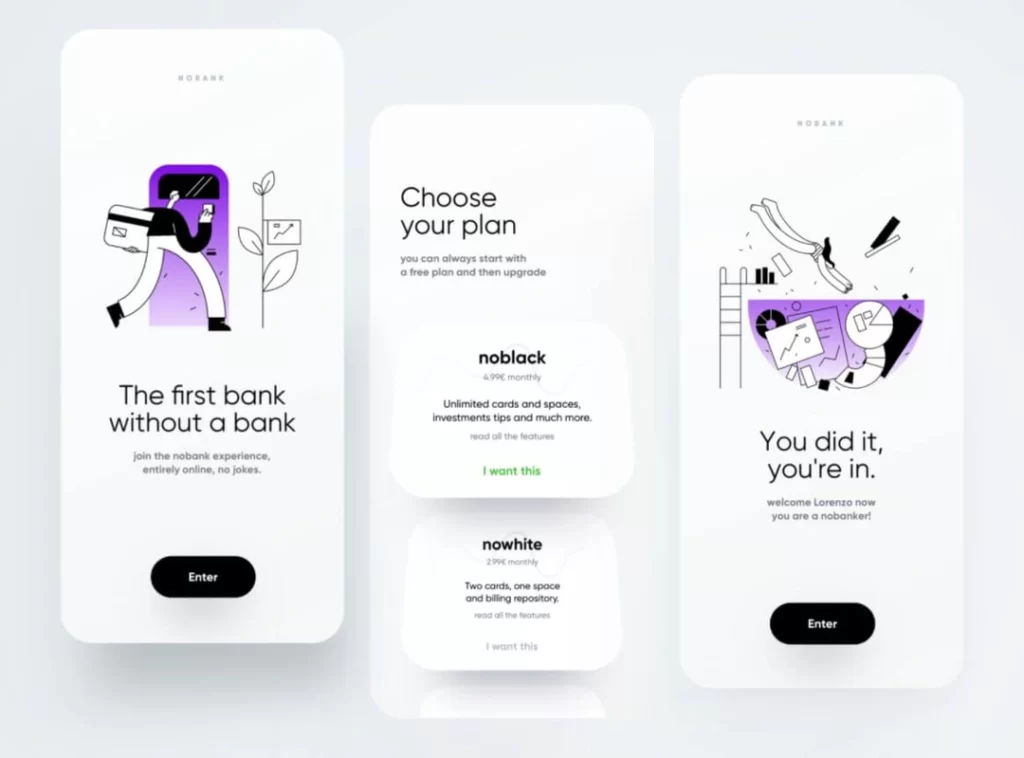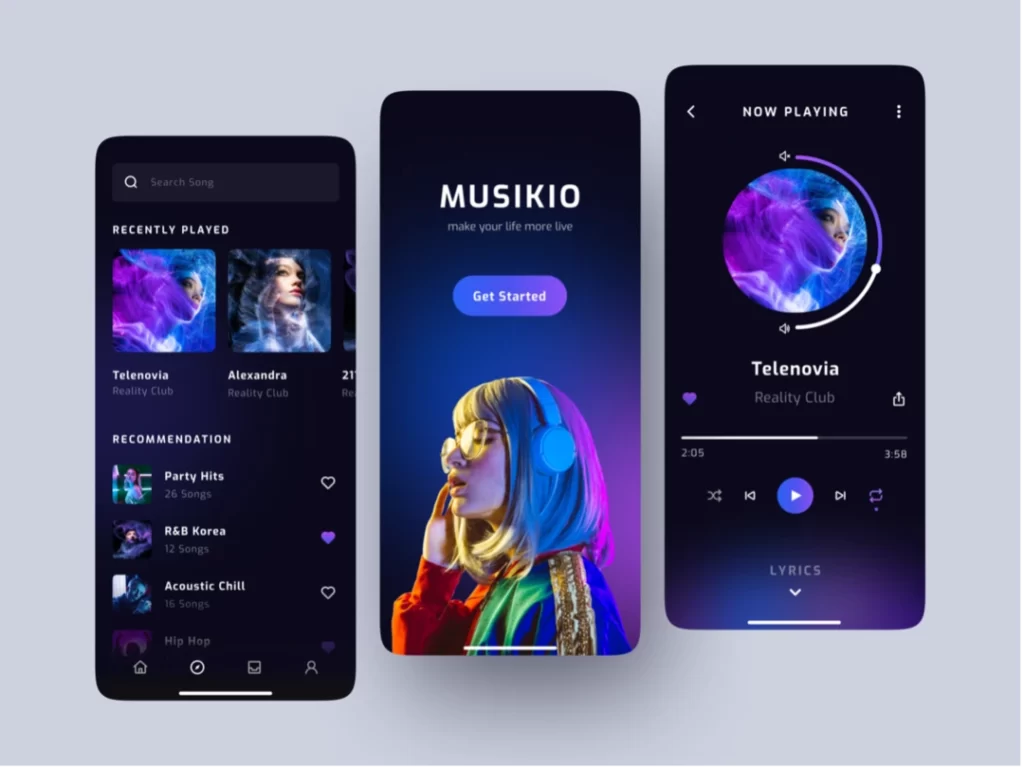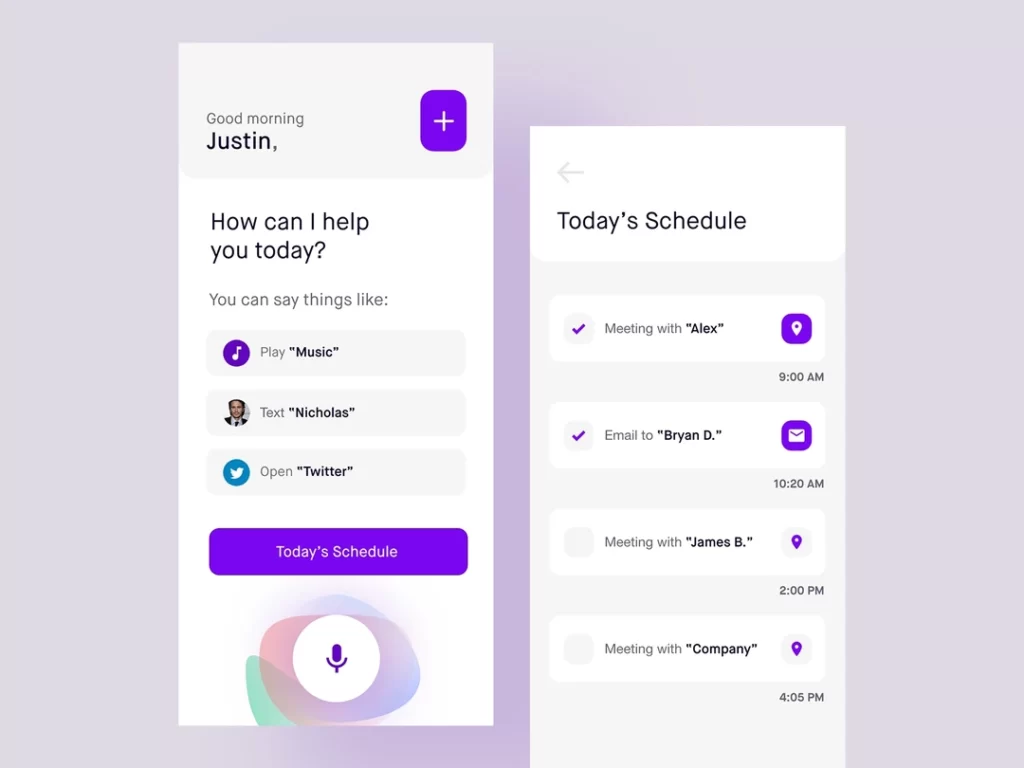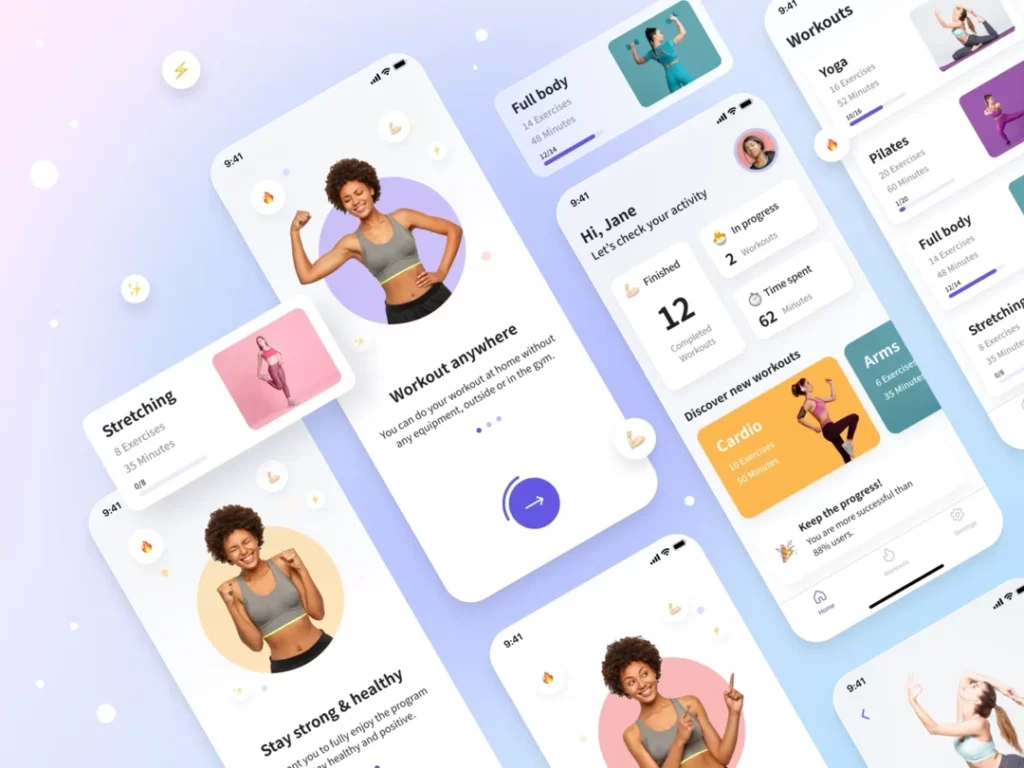The Future of Creativity: 7 App Design Trends Shaping Our World
The digital landscape is constantly evolving, and so are the trends in creative app design. In today's highly competitive market, staying ahead of the curve is crucial for app designers who want to create memorable and engaging user experiences.
This article explores some of the industry's most exciting and innovative app design trends. We'll discuss how these trends are changing how we interact with our devices and how they're influencing the future of app development.
Table of Contents
1 – Minimalism: Less is More

Minimalism has been a dominant trend in app design for quite some time, and it maintains its stronghold in digital experiences. This design philosophy, which is all about simplicity and elegance, emphasises the following key aspects:
Simple and Clean Interfaces
Minimalist app design is characterised by clutter-free interfaces that allow users to focus on what's essential. By removing unnecessary elements, designers can create a more visually appealing and user-friendly experience, allowing users to navigate the app easily.
Efficient Use of Whitespace
Whitespace, also known as negative space, plays a crucial role in minimalist app design. By strategically using whitespace, designers can create a sense of balance and harmony within the interface, guiding the user's eye and making it easier to understand the app's structure and hierarchy.
Intuitive Navigation
One of the core principles of minimalist app design is ensuring that users can effortlessly navigate the app. This is achieved by employing clear and consistent design elements, such as buttons, menus, and icons, that help guide users through the app without confusion or frustration.
Focus on Essential Features
Minimalism in app design prioritises functionality and user experience above all else. By concentrating on the most critical features and eliminating unnecessary ones, designers can create a more streamlined experience that caters to the user's needs without overwhelming them with choices.
As users become increasingly comfortable with mobile technology, they crave simplicity and seamless experiences that make their lives easier. Minimalism in app design helps meet these expectations by removing distractions and focusing on what truly matters. This approach creates a more enjoyable user experience and increases engagement and retention rates.
By embracing minimalism in app design, developers can create visually appealing, highly functional, and user-friendly apps that stand out in a crowded marketplace. As we move forward in this ever-evolving digital landscape, the power of simplicity in app design will continue to be a driving force, shaping how we interact with technology and transforming our digital experiences.
2 – Dark Mode: Embracing the Night

Dark mode has become increasingly popular in recent years, with more and more apps embracing this feature as an integral part of their design. This shift towards dark mode reflects the changing preferences of users and offers several key benefits that enhance the overall user experience. Some of the most notable advantages of dark mode include the following:
Reduced Eye Strain in Low-Light Conditions
One of the primary reasons behind the popularity of dark mode is its ability to reduce eye strain, particularly in low-light environments. Dark mode swaps the traditional light background with a darker one, minimising the amount of light emitted by the screen. This reduces glare and makes it easier for users to read content without straining their eyes, leading to a more comfortable experience, especially during nighttime use.
Extended Battery Life for OLED and AMOLED Screens
Another significant advantage of the dark mode is its potential to extend battery life on devices with OLED and AMOLED displays. These screens consume less power when displaying darker colours, as individual pixels can be turned off entirely when showing black. By incorporating dark mode, app designers can help users conserve battery life, a valuable feature in today's fast-paced, mobile-driven world.
Aesthetic Appeal
The dark mode also offers a fresh, modern aesthetic that many users find visually appealing. Using darker backgrounds and contrasting colours can create a sleek, sophisticated look that differentiates an app from its competitors. In addition, the dark mode can provide a sense of consistency across various apps and devices, creating a unified and immersive user experience.
By incorporating a dark mode option into their designs, app developers can cater to evolving user preferences and improve the overall usability of their apps. This feature not only enhances the visual appeal of an app but also addresses critical concerns such as eye strain and battery life, making it a must-have for modern app design.
As dark mode continues to gain traction, we can expect to see even more innovative and creative implementations of this feature in the world of app design. By staying ahead of this trend, app developers can ensure their creations remain relevant and appealing to users in an ever-changing digital landscape.
3 – Custom Illustrations: Adding Personality

Custom illustrations are gaining tremendous popularity in app design as they bring a unique and personal touch to the user experience. This trend sets apps apart from competitors, injecting character and life into digital interfaces. Custom illustrations in app design encompass several elements, including:
Hand-Drawn Graphics
Hand-drawn graphics bring an organic, authentic feel to app design, setting it apart from the often sterile, cookie-cutter aesthetic of stock graphics. These bespoke illustrations showcase designers' creativity and artistic talent, making each app more distinctive and memorable.
Unique Colour Schemes and Styles
Custom illustrations allow experimenting with unique colour schemes and styles that align with a brand's identity. Using a cohesive and distinct colour palette, designers can create a visually appealing and instantly recognisable experience that resonates with users and builds brand loyalty.
Emphasis on Storytelling and Emotion
One of the most significant aspects of custom illustrations is their ability to tell stories and evoke emotions. By incorporating illustrations that convey a narrative or represent users' emotions, designers can create a deeper connection between the app and its users. This emotional connection can foster long-term engagement and user satisfaction.
Custom illustrations are crucial in shaping memorable user experiences and strengthening brand identity. By incorporating hand-drawn graphics, unique colour schemes, and an emphasis on storytelling and emotion, designers can create a compelling and visually engaging experience that sets their app apart from the competition.
As the digital landscape becomes increasingly saturated, custom illustrations offer a powerful way for app designers to differentiate themselves and create lasting impressions on users. By embracing this trend, designers can infuse their creations with personality and uniqueness, elevating the user experience and ensuring their apps stand out in a crowded marketplace.
4 – 3D and Augmented Reality: Engaging the Senses

Integrating 3D graphics and augmented reality (AR) in app design is gaining momentum, bringing many new possibilities and opportunities for creating immersive, interactive experiences. These cutting-edge technologies provide numerous advantages, including:
Immersive and Interactive Experiences
3D graphics and AR have the power to transform the way users interact with apps, creating experiences that are more engaging, immersive, and interactive. By incorporating these technologies, designers can bring content to life, allowing users to interact with virtual objects in real-world environments, increasing user engagement and satisfaction.
Enhanced Visual Appeal
3D graphics and AR can significantly enhance the visual appeal of an app, making it stand out in the crowded app marketplace. Using these advanced technologies, designers can create visually striking interfaces that capture users' attention and pique their interest. This can help set an app apart from its competitors and make it more memorable in users' minds.
Opportunities for Innovative Functionality
3D graphics and AR open up new avenues for innovative functionality in app design, enabling developers to create unique features that push the boundaries of what's possible in the digital realm. For example, AR can create interactive shopping experiences, allowing users to virtually try on clothes or see how furniture would look in their homes before purchasing. Similarly, 3D graphics can create complex game environments that offer users a more engaging and dynamic gaming experience.
By incorporating 3D and AR elements into app design, developers can create unique, captivating experiences that blur the lines between the digital and physical worlds. These technologies enhance the visual appeal of apps and provide opportunities for creating innovative features and functionalities that redefine what's possible in app design.
As 3D graphics and augmented reality evolve and become more accessible, we can expect to see even more exciting and groundbreaking applications of these technologies in app design. By staying ahead of these trends, developers can ensure their creations remain relevant, engaging, and inspiring for users in an ever-changing digital landscape.
5 – Voice and Gesture Control: Hands-Free Interaction

Voice and gesture control transform how we interact with our devices, heralding a new era of hands-free interaction. This rapidly evolving trend focuses on several key aspects, including:
Reducing Reliance on Touch-Based Inputs
By incorporating voice and gesture control into app design, developers can reduce the need for touch-based inputs, the predominant mode of interaction on smartphones and tablets. This shift towards hands-free interaction offers users greater flexibility and convenience when using their devices, especially when touch-based inputs may not be practical or desirable.
Enhancing Accessibility for Users with Disabilities
Voice and gesture control can significantly enhance the accessibility of apps for users with disabilities, for individuals with limited mobility or those who face difficulty using touch-based inputs, voice commands and gesture recognition can provide an alternative means of interacting with devices, enabling a more inclusive and accessible experience for all users.
Creating More Natural and Intuitive User Experiences
As voice assistants and gesture recognition technology become more advanced, they enable more natural and intuitive user experiences that closely resemble human communication and interaction. By integrating these features into app design, developers can create more human-like experiences, making it easier for users to engage with their devices and fostering a more profound sense of connection.
As voice assistants, such as Siri, Google Assistant, and Alexa, and gesture recognition technology continue to improve and become more widely adopted, app designers have a unique opportunity to create more seamless and inclusive experiences. By integrating these features into their apps, developers can cater to users' evolving needs and preferences, ensuring their creations remain relevant and engaging in a rapidly changing digital landscape.
Integrating voice and gesture control in app design not only breaks down barriers for users with disabilities but also paves the way for more natural, intuitive, and immersive digital experiences. As this trend continues to gain momentum, we can expect to see even more innovative and groundbreaking voice and gesture control applications in app design.
6 – Microinteractions: Delighting Users

Microinteractions are subtle, often overlooked animations that breathe life into an app's interface, adding depth and personality to the user experience. These seemingly insignificant design elements are crucial in creating a unique and engaging app environment. The key benefits of micro-interactions include the following:
Improved User Engagement
Microinteractions are delightful surprises that capture users' attention and keep them engaged with the app. By incorporating these small animations into app design, developers can create a more dynamic and interactive experience that encourages users to explore and interact with the app further.
Providing Feedback and Guidance
One of the primary functions of micro-interactions is to provide users with feedback and guidance, helping them understand the consequences of their actions within the app. For example, a button that changes colour or animates when tapped can indicate that an action has been completed. These visual cues can make users feel more confident and in control of their experience, leading to higher satisfaction and retention rates.
Enhancing the Overall Aesthetic
Microinteractions can also enhance the overall aesthetic of an app, adding a layer of polish and sophistication that sets it apart from the competition. By carefully designing and implementing these subtle animations, developers can create a visually appealing and cohesive experience that resonates with users and builds a strong brand identity.
Developers can create more enjoyable, memorable, and engaging user experiences by incorporating micro-interactions into app design. These small yet impactful design elements not only serve to improve user engagement but also provide valuable feedback and guidance, ensuring that users feel confident and in control of their interactions with the app.
As the digital landscape evolves, micro-interactions will become increasingly important in shaping how users interact with and perceive apps. By embracing this trend and integrating micro-interactions into their designs, app developers can elevate their creations to new heights, ensuring they stand out in a crowded marketplace and leave a lasting impression on users.
7 – Biometric Authentication: Enhanced Security

As security and privacy concerns continue to escalate, biometric authentication is becoming increasingly prevalent in app design. This cutting-edge trend uses users' unique biological traits to provide a more secure and seamless authentication process. Biometric authentication involves several key aspects, including:
Fingerprint, Facial, or Iris Recognition
Biometric authentication relies on various techniques to verify a user's identity, such as fingerprint, facial, or iris recognition. These methods leverage the unique biological characteristics of individuals, making it far more difficult for unauthorised users to access sensitive data or accounts.
Increased Protection of Sensitive Data
With the growing importance of data protection, biometric authentication offers enhanced security for sensitive information. By incorporating biometric authentication methods into app design, developers can ensure that only authorised users can access critical data, reducing the risk of data breaches and identity theft.
Simplified User Authentication
Biometric authentication streamlines the user experience by reducing the need for traditional authentication methods, such as passwords and PINs. This simplifies the login process and eliminates the need for users to remember multiple passwords or risk having their accounts compromised due to weak or reused credentials.
By integrating biometric authentication into app design, developers can address growing security and privacy concerns while providing a more seamless and user-friendly experience. This approach enhances the overall security of apps and ensures that users can access their accounts and data with minimal friction and maximum confidence.
As biometric authentication technology continues to advance and become more widespread, it will likely play an increasingly important role in shaping the future of app design. By staying ahead of this trend, developers can create apps prioritising security and privacy while delivering a smooth and enjoyable user experience.
Concluding the App Design Trends
As technology advances and user expectations evolve, app designers must stay abreast of the latest trends to create compelling and engaging experiences. The trends discussed in this article—minimalism, dark mode, custom illustrations, 3D and AR, voice and gesture control, micro-interactions, and biometric authentication—all play a crucial role in shaping the future of app design.
Embracing these app design trends leads to more aesthetically pleasing and user-friendly apps and new avenues for innovation and growth. By staying ahead of the curve, app designers can ensure their creations remain relevant and appealing in a rapidly changing digital landscape.
Ultimately, the future of app design trends will be shaped by those who dare to think outside the box, pushing the boundaries of creativity and technology to deliver exceptional experiences that delight, engage, and inspire users. As we move forward, it will be fascinating to see how these trends continue to evolve and what new possibilities they unlock in app design.
